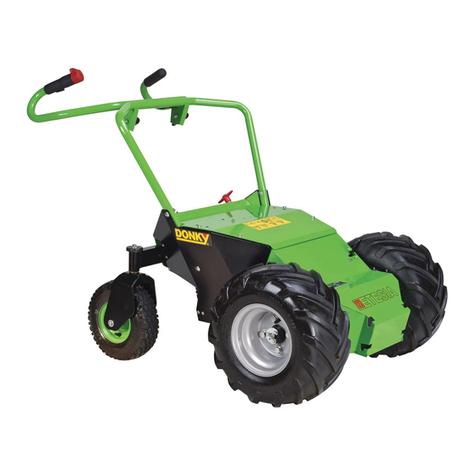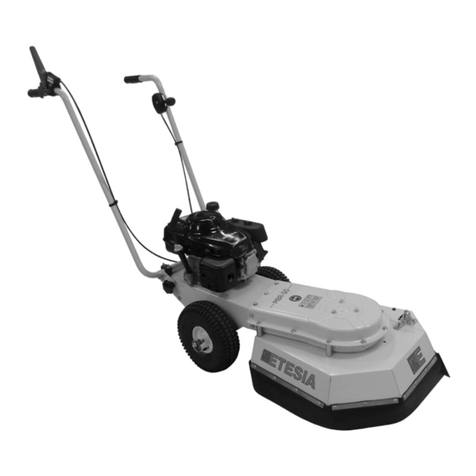
4
2• YOUR SAFETY AND THAT OF OTHERS
2•1 USING IN CONFORMITY WITH THE
INTENDED PURPOSE
• The machine has been manufactured in accordance with the
current state of manufacturing techniques and recognised safety
rules. Using it may nevertheless carry a risk of bodily injury for
the user or third parties or of damage to machine or other mate-
rial goods.
• Only use the machine when it is in perfect condition technically
and in accordance with the intended use, observing the servicing
instructions, taking safety into consideration and being aware of
the danger! Immediately repair (or have repaired) any malfunc-
tion liable to compromise safety!
• The machine is intended only for scarifying. Any other use is
out of conformity. The manufacturer/supplier declines all res-
ponsibility for damage that might result from other use. The
user alone assumes the risks.
2•2 ORGANISATIONAL MEASURES
• The service manual must always be available and at hand where
the machine is being used.
• In addition to the service manual, observe the general provision
of the law and other obligatory regulations for the prevention of
accidents and protection of the environment.
• These obligations may also concern, e.g. handling dangerous
materials, availability/wearing of protective clothing and rules
for the use of public highways.
• Supplement the service manual by instructions including the
obligation for surveillance and information in order to take into
consideration the particular nature of operation, such as the orga-
nisation or conduct of work or working personnel.
•
The personnel who are to work on the machine must read the
service manual before starting work, and in particular the sec-
tion «Your safety and that of others». This especially applies to
personnel who work only occasionally on the machine, e.g. for
assembly or servicing.
• Ensure, at least from time to time, that the working personnel
are observing the safety rules and are aware of the danger, and
that they are observing the instructions in the service manual!
• Beware of long hair and do not wear baggy clothing or jewellery
(including rings)! There is a danger of injury by getting caught
up or drawn in.
• Use personal protection equipment if necessary or if the regula-
tions require you to do so!
• Observe all the instructions on safety and hazards marked on the
warning plates fixed on the machine.
• Make sure all the warning plates on safety and hazards fixed to
the machine are always complete and legible!
•
If there are any changes that affect safety, immediately stop the
machine and inform the competent personnel.
• Do not carry out any modifications and do not fit any supple-
mentary parts to the machine that may affect safety without the
supplier’s authorisation. This also applies to fitting and adjusting
devices and safety valves and for welding on load bearing parts.
• Spare parts must meet the technical requirements set by the
manufacturer. This is always guaranteed for original spares.
• Carry out periodical inspections at the prescribed frequency or
as indicated in the service manual!
• Adequate workshop equipment for the work to be done is abso-
lutely necessary for maintenance.
• Make known the locations of extinguishers and give instructions
on how to use them!
• Observe the ways of raising the alarm and fire fighting!
2•3
SELECTION AND QUALIFICATION OF
PERSONS, BASIC OBLIGATIONS
• Only a reliable person can work on/with the machine. Respect
the legal minimum age! Only use trained or initiated personnel,
clearly define the skills of the personnel for operation, assembly,
servicing and repair! Ensure that only qualified personnel work
on/with the machine!
• Determine the responsibility of the machine operator - also the
responsibility concerning the legal regulations for the use of
public highways - and authorise him or her to refuse instructions
contrary to safety given by third parties!
• Personnel in training, apprenticeship, initiation or operating
as part of general training can only work on/with the machine
under the permanent supervision of an experienced person!
• Work on the electrical equipment of the machine can only be
carried out by an electrical specialist or by persons initiated in
the management and supervision of an electrical specialist and
according to the rules of electricity technique.
• Never allow children or other persons not familiar with the user
manual to use the machine. Local directives may set the mini-
mum age for persons using the machine.
•
Never use the machine when there are persons, especially
children, nearby. Remember that the driver or operator of the
machine is responsible for accidents or risks affecting other per-
sons or their material property.
• Wear ear defenders and safety goggles while the machine is run-
ning. Strong shoes and long trousers must always be worn while
working with the machine. Do not use the machine barefoot or
wearing sandals.
• Inspect the terrain on which the machine is to be used and
remove stones, sticks, wire or other foreign bodies that might be
snatched up and projected.
• WARNING! Petrol is highly flammable. Only store petrol in
containers specifically designed for the purpose. Only fill the
fuel tank in the open air and do not smoke while doing so.
• Fill the tank before starting the engine. Do not open the fuel
tank or top up with fuel while the engine is running or the motor
is hot.
•
If diesel is spilt, do not attempt to start the engine: remove the
mower from the affected area and take care not to ignite any
undispersed diesel vapour.
• For safety reasons, petrol tank or other caps must be replaced
when damaged.





























